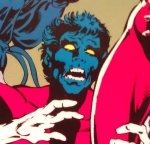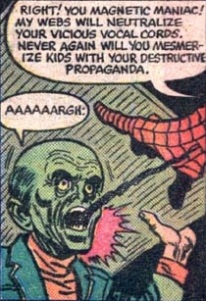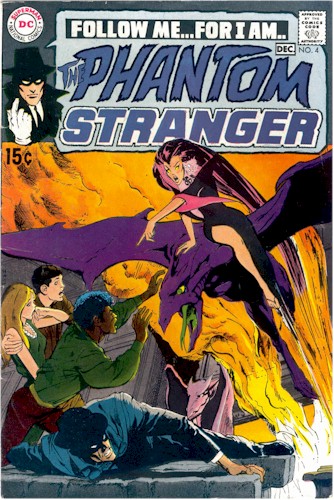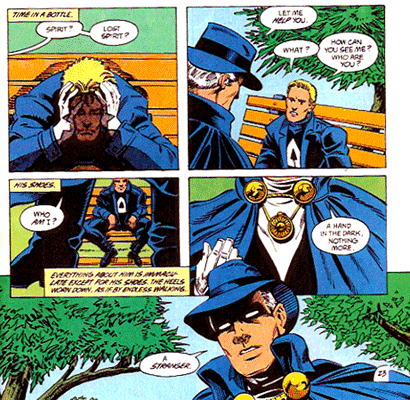Posts Tagged ‘The Bronze Age’
Today’s post gives me the opportunity to introduce a new category for Bronze Age comics I’ve called: “Love for the Bronzer”.
You may not realize this, but Dr. Strange and the Man-Thing have have something in common: murderous Christians hate them.
I suppose in Strange’s case it makes a bit of sense. Since the Julio Claudian dynasty, paganism and Christianity have butted heads. Add a little Constantinian conversion, a bit of Julianian conservatism, and you’ve got a recipe that has left polytheism and monotheism standing on opposite sides of the Deity Dance Floor glaring one at the other for the last 2000 years. So when Marvel debuted their protagonist of polytheistic persuasion in Strange Tales #110, it was only a matter of time before Christianity took a stab at him, and in 1974 that’s exactly what it did. Enter the Silver Dagger, a knife-dipped-in-holy-water wielding ex-Cardinal who left the Church after being denied the Papacy. What was Dagger’s next move? Why, he became a sorcerer and took to killing off all practitioners of the mystic arts, of course!
And so it was that in Doctor Strange#1 this occult antagonist set his sights on Stephen Strange and the Sorcerer Supreme’s bombshell apprentice Clea. After three issues of fabulous story and gorgeous art the murderous mage was finally banished to unreality forever. Hooray!
What is a bit more – well – strange, is that exact same year the Man-Thing faced a similar foe. Man-Thing #s 3 & 4 featured the less poetically named Foolkiller as he attempted to rid the earth of fools and sinners with his Yahweh-bequeathed Purification gun. Foolkiller was a lost soul who got picked up in that hippie Christian Jesus Movement and found peace at last. Unfortunately, that peace was shattered when he walked in on his pastor getting drunk with some floozy. After being told to take life less seriously the Foolkiller went berserk, strangled the preacher, preserved his corpse in a shrine, received a laser gun from God (for some reason God armed this guy), loaded his gun and his shrine in a van and took off across America killing all the “fools” along the way. On one of his death quests, Foolkiller’s plot is foiled by the unwitting Man-Thing and from that point on Foolkiller has a score to settle.
Unfortunately for both Foolkiller and the Man-Thing, this swamp monster can’t exactly be killed. Foolkiller goes about his business of trying to get the local radio station to stop playing “blasphemous” music and is ultimately killed during a fight with Man-Thing when the Dead Preacher Shrine falls over and a large shard of glass pierces Foolkiller’s heart.
I don’t know if there is any connection between these two stories. The Jesus Movement was all over the US, and Protestants and Catholics were really going at it in Ireland around this time, but that’s all I can think might have inspired these two stories such a short time from each other. In any case I still effing love the Bronze Age of Comics and I’ve learned just how dangerous a knife dipped in holy water or a God-sent laser blaster can be, so it’s a win/win for me. It’s been a long time since anybody did a “Reviews & Booze” write up, so I’m gonna go ahead and recommend some red wine for this one.
Happy readings!
-Jonny
Comics In Arrested Development
Posted on: March 20, 2011
I haven’t written for High Five in some time now. To be fair I never contribute too heavily and a disruption is measured in months not weeks, but really I haven’t been writing because I haven’t kept up with new comics. Sure, I hit the shop every week and often pick up a book or two, but for the most part the modern world isn’t grabbing me right now.
They say that 1985 is the year comics grew up. Well, I was born in ‘82 which means comics grew up before I did. Mine was a generation that had a kick-ass X-Men cartoon on TV, Superman died when we were still in grammar school, and most of us didn’t realize until later that Wolverine’s hair isn’t actually so out of control.
Since comics matured before I could form memories, my taste in comics has always been “grown up”. Writers like Moore, Ellis, Azarello, and Willingham dominate my bookshelf and before 2010 would have been quickly rattled off in reply had you asked who my favorite comic writers were; which is why I’ve taken a break from all this intensity and have spent the last 6-9 months reading Gold, Silver, and Bronze Age comics almost exclusively.
I’ll be the first to admit that this stuff is incredibly campy and many of the stories don’t make a whole ton of sense, but when you get past the modern bias against silliness a whole world of innocent amazement opens to you. At SDCC 2010 Grant Morrison pointedly remarked, “We’ve already got the real world. Why do you want comics to be like that one?” which sums up how I feel about comics right now. I ask you: what’s so great about “realistic” dialogue? Why should I read about characters going through intense emotional pain? Why not read about amazing people fighting fantastical fights as pure good battles pure evil with no grey areas to bog us down? Some of you will tell me I’m just unevolved, but seriously: isn’t there room for both? Does one really preclude the other?
Maybe I’m becoming cynical as I age, sinking into some horrid pessimism (or escapism), but I feel like the real world around me is pretty f***ed up most of the time and I’ve gotten tired of reading comics that depict a world equally f***ed up. Nobody is dying when I read Planet Comics, Len Wein could write Phantom Stranger stories that were mysterious without being disturbing, I read Jack Kirby without turning my stomach, and Walt Kelly is pure delight. I’m telling you guys, this is the magic that made comics great.
Don’t get me wrong; I’m not knocking the modern creators. I just read Outlaw Nation with much enjoyment and I swear I’m gonna finish 100 Bullets one of these days, but for now and the foreseeable future the world before 1985 is captivating my attention and I feel like I could never leave.
Happy readings,
-Jonny
 Right around the transition from the Silver Age to the Bronze Age, comics loved to start getting into some real serious shit, both in regular series and non-canon PSA comics presented by third party organizations. Marvel cranked out more of these than anybody so a crazy amount of these involved your friendly neighborhood Spider-Man. A lot of these PSA comics managed to score some industry greats too, what with Danny Fingeroth telling us about epilepsy awareness, Bill Rosemann getting kids to respect power tools, and Howard Mackie and Al Milgrom warning us about proper tooth brushing habits (yeah, all of these are real books).
Right around the transition from the Silver Age to the Bronze Age, comics loved to start getting into some real serious shit, both in regular series and non-canon PSA comics presented by third party organizations. Marvel cranked out more of these than anybody so a crazy amount of these involved your friendly neighborhood Spider-Man. A lot of these PSA comics managed to score some industry greats too, what with Danny Fingeroth telling us about epilepsy awareness, Bill Rosemann getting kids to respect power tools, and Howard Mackie and Al Milgrom warning us about proper tooth brushing habits (yeah, all of these are real books).
But forget those stories. This is far and away my favorite of all the bizarre Spider-Man PSAs, Spider-Man Vs. The Prodigy, in which he faces his most heinous villain yet: teenage boners!
In 1976, Planed Parenthood decided that there were way too many kids running around, fucking the bejeezus out of one another. One call to Marvel later and we end up with one of the most bizarre books I’ve ever read, written by Ann Robinson (who I’m pretty sure wasn’t normally a writer, but the lady in charge of Marvel’s licensing) and penciled by the legendary Ross Andru.
Our PSA starts with Spider-Man climbing the Pan Am building and talking smack on Dr. J when he notices a bunch of teenagers filing into a helicopter. Immediately, Spider-Man gets suspicious. These kids don’t look upper class and look more like “they should be home listening to their new Henry Gross albums.” It’s worth noting that Ann Robinson was married to record producer Tommy West, the guy who produced Henry Gross’ albums around this time. Promoting your husbands’ albums in a quip made by Spider-Man in a free book distributed to kids by Planned Parenthood? Classy!
We cut to a giant mansion where a space alien from the planet Intellectia monologues about his plan to get on national television and use his “magnetic monotone” (according to the caption, his spaceship has shitty shields and the radiation absorbed while passing through the Earth’s ionosphere caused him to get the power to have a persuasive sounding voice) to brainwash America’s youth into making “stupid mistakes.” And what is his plan? Telling them to fuck, kidnapping the babies, and taking them back to Intellectia for child labor!
Back at the Pan Am building, Spidey decides to attach himself to the helicopter and hitch a ride to wherever it’s going. Of course, it ends up at the mansion. As soon as the helicopter lands, the kids are ushered into a classroom where the alien begins teaching them that grown-ups tell them to wait to have sex because they secretly don’t want kids to have a good time. He then tells the kids that unprotected wanton sex is the only way for a teenage boy to “prove hes a man.” And when hes questioned by some of the kids about how that goes against everything their sex ed teachers said, he just replies that getting pregnant is good for you because it “Clears up acne.” After finding out about his upcoming appearance on national television, Spider-Man has heard enough. He makes a totally not-at-all dated Marcus Welby, M.D. joke and springs into action.
Well, Spider-Man doesn’t get far before he’s spotted by the machine gun-wielding guards who chase him onto the roof. Spider-Man crouches down and pretends to be a gargoyle (seriously) but that doesn’t work because the guards aren’t complete idiots. Spidey knocks them all out between panels and makes his way to the mansion’s private TV studio. He waits outside for the broadcast to start and then smashes the window and rips off the alien’s mask revealing to the world that he actually just kinda looks like a green Sinestro. After Spider-Man wags his finger at the alien for a couple panels, he decides that he needs to “end the power of the Prodigy” (the first time the alien is given a name) and shoots webbing down his throat. One thumbs up to the camera later and the story abruptly ends.
The last three pages of this 18 page book are dedicated to Spidey Facts about everything sex and advertisements for other Planned Parenthood literature with weird titles (what the hell is The Sex Alphabet?). Man, people in the 1970s believed some weird shit. My favorites are that “masturbation won’t make you insane” and that “doctors are both men and women and so are nurses.” You know what? Here. I’ll just show you that whole awkward page.
So, there you have it. The best of the worst of the Bronze Age Marvel comics PSAs. You know, for being as awkward and as terribly written as this book is, Ross Andru still seems to have given it his all. At least it has that going for it, right?
[Subscribe to High Five! You know you wanna.]
 Hi, folks! Jonny here. The Underrated Underdogs feature has always been one of my favorites at High Five. Rob and Maggie know a lot about that stuff and I always love it when they review some old character I’ve never heard of. I have always wanted to review my own underdog, and a year into High Five I’ve finally found my guy.
Hi, folks! Jonny here. The Underrated Underdogs feature has always been one of my favorites at High Five. Rob and Maggie know a lot about that stuff and I always love it when they review some old character I’ve never heard of. I have always wanted to review my own underdog, and a year into High Five I’ve finally found my guy.
In 1952 DC Comics broke with common practice and introduced a new character without testing his/her popularity in one of their existing on-going titles. Since the success of any new character is uncertain, most new heroes are brought along side an existing character (IE Wolverine in Hulk #181) or receive a showcase slot in a short story magazine like More Fun Comics. Apparently the word of John Broome (Elongated Man, Detective Chimp) was enough to entice DC to take a few risks, and in August or September of 1952 the world met the Phantom Stranger in his very own six issue miniseries. Likely the gambit didn’t pay off because the Phantom would not reappear until February 1969 in Showcase #80 along side Doctor Thirteen. From this rebirth we come to know our hero.
The original concept behind the Phantom Stranger was quite simple: a crime with inexplicable causes would be perpetrated and the mysterious Phantom Stranger would appear from no-where, expose the supernatural as a hoax, and vanish leaving the audience to debate his true nature. Usually he was working along side Doctor Thirteen who was consistently annoyed at the mystery surrounding Phantom Stranger.
Apparently this concept targeting young boys didn’t work for DC and in issue 4 The Phantom Stranger received a new creative team, a new costume, and some badass powers that quickly settled the question of natural vs spiritual. Beyond aesthetic alteration, the changes wrought by Robert Kanigher (creator of Barry Allen) and Neal Adams (who’s drawing an upcoming Batman book this summer YAY!) demonstrated a shift in target demographic. No longer did our hero spend his time mystifying 7 to 10 year-olds with disappearing acts. This new Phantom Stranger’s friends were teens, and hippies at that. His enemies were no longer simple-minded murderers or thieves, but rather the Forces of Evil themselves. This series continued throughout the first half of the 1970s and boasted such creators as Len Wein, Jim Aparo, and Tony DeZuniga. Check out the cover art for the first issue of Phantom Stranger under Kanigher and Adams below:
By 1973 the Silver Age was over, and the Bronze Age was in full swing. This shift saw a population with little interest in many of the once popular characters. Phantom Stranger was a casualty of this shift and he largely faded into Limbo until Alan Moore reminded us of the mysterious hero in 1982’s Saga of the Swamp Thing.
Here, we saw the beginnings of Phantom Stranger’s third and current interpretation. To Moore, and all subsequent writers, the Phantom Stranger was not a being of power. Rather, he was an all-knowing sage who transcends time, space, and continuity. No matter where you are in the DCU, The Phantom Stranger can find you, and he can guide you to a better path. This concept was beautifully illustrated by Grant Morrison in Animal Man #22 when Phantom Stranger met a time-displaced Buddy Baker and helped him find the path to his lost family.
What I find remarkable about the Phantom Stranger is that the character holds up perfectly despite all the ret-cons and reinterpretations. Since the character was built on a simple platform of perpetual mystery the changes have not affected DC’s immortal sage to any detriment. In fact, the changes have made him even cooler. DC has issued 4 theories as to his origin. None are to be taken as fact, and all are meant to further the mystery. But, in my mind, The Phantom Stranger represents some overreaching Power in the DCU that has sent its messenger to earth in 3 phases: first to observe, second to fight, and third to guide.
I love this interpretation for a few reasons. One, it gives Phantom Stranger a certain realism of character in that he has matured rather than simply aged. Second, and more importantly it mirrors the path of humanity as we begin, live, and complete our lives. This is, of course, my own interpretation for my own amusement, but the fun of any mystery is in the guessing.
Happy readings,
-Jonny
[Liked this post? Vote it up on reddit!]










